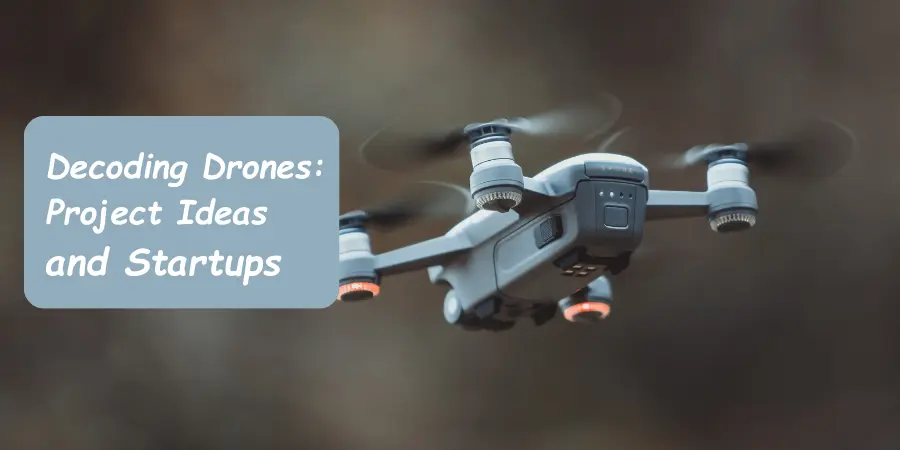Decoding Drones: From “Drone Kya Hai” to Project Ideas and Startups

Exploring the world of drones unveils a trove of possibilities, prompting the question “Drone Kya Hai?” or “What is a drone?” Drones, often seen as harbingers of innovation, extend their reach into diverse applications, from aerial photography to advanced agriculture.
Startups and tech enthusiasts are decoding drones, transforming this curiosity into tangible project ideas and innovative startups. These ventures leverage drones’ versatility to address complex issues, offer logistic solutions, and promote environmental stewardship. The potential drones hold for these pioneering enterprises is vast, offering a bird’s-eye view of what’s on the horizon for technology and business.
The transition from understanding ‘Drone Kya Hai’ to launching a drone-focused startup symbolizes the growth of a tech-savvy culture ready to embrace the challenges and opportunities of the future. Advantages and laws play a crucial role in navigating this evolving landscape.
What is Drone? (Drone kya hai?)
Unmanned aerial vehicles (UAVs), commonly referred to as drones, have completely changed sky exploration. “Drone kya hai?”—or “what is a drone?” These devices embody advanced engineering, capable of precision and autonomy that transform numerous industries.
Photography has been revolutionized by drones, offering new perspectives and unparalleled aerial shots. Their value extends into agriculture for crop monitoring, logistics for delivering packages, and disaster management for real-time risk assessments. As DJI dominates the market, it sets the standard for drone technology, shaping the industry’s trajectory.
Considering “drone kya hai” invites us to see drones as symbols of human innovation, seamlessly integrating into the tapestry of modern technology and expanding our reach into the skies. However, it’s essential to be aware of the disadvantages of relying too heavily on drones and the legal considerations, especially in India’s burgeoning drone startup landscape.
Drones Advantages and Disadvantages:
Advantages:
- Reach: Access hard-to-reach places.
- Cost: Generally cheaper than manned aircraft for many tasks.
- Safety: Reduce risks by taking on tasks that would be dangerous for humans.
- Efficiency: Complete certain tasks more quickly than humans.
- Data: Collect detailed information for various uses.
Disadvantages:
- Privacy: Potential for privacy invasion.
- Security: Can be used for unauthorized activities.
- Regulation: Complex and sometimes unclear laws.
Drones on Rent: Overview
- Accessibility: Drone rental services make it easier for people and organizations to gain access to drone technology without the upfront cost of acquiring a drone.
- Variety: Renters have access to a large selection of models that are appropriate for a variety of uses, including photography, surveying, and agricultural work.
- Cost-Effective: It is cost-effective for short-term needs or one-off projects.
- No Maintenance: Renters are not responsible for the maintenance or updates of the drones.
- Trial: It’s an excellent way to test different drones before deciding to purchase one.
- Professional Use: Businesses can use rental services to provide services like aerial photography or land surveying without significant investment.
Points to Consider:
- Insurance: Renters should ensure they have adequate insurance to cover potential damage or liability issues.
- Regulations: Renters must be aware of and comply with local drone regulations.
- Skill Level: Operating a drone requires skill, and renters should have the necessary experience or consider hiring a qualified pilot.
Drone Project Ideas: Innovations from the Sky
1. Captivating Aerial Photography: Drones revolutionize photography by capturing breathtaking aerial shots, making it an ideal project for photographers and filmmakers. Whether it’s for real estate showcases, landscape photography, or event filming, the sky’s the limit with drone imagery.
2. Precision Agriculture: Tech-savvy farmers and agronomists can leverage drones for precision agriculture projects. Drones equipped with advanced sensors can monitor crop health, improve farm efficiency, and reduce costs by providing detailed aerial views that traditional methods cannot.
3. Life-Saving Search and Rescue: Drones can be literal lifesavers. By equipping drones with thermal imaging cameras, search and rescue teams can locate missing persons in challenging terrains, making this a project that combines technology with humanitarian efforts.
4. Environmental Protection Initiatives: Conservationists can use drones for environmental monitoring projects. Drones make it possible to track wildlife populations, enforce anti-poaching measures, and monitor ecological changes without disturbing the natural habitat.
5. Groundbreaking 3D Mapping: Drones are transforming the surveying and mapping industry. Projects that focus on 3D mapping with drones can support urban planning, construction, and historical preservation efforts by providing accurate and detailed geographical data.
6. Disaster Response and Assessment: Quick disaster response is critical, and drones can be at the forefront. They can assess damage, locate survivors, and map out safe routes for rescue workers, proving invaluable for disaster management and mitigation projects.
7. Educational Tools and Programs: Drones can take STEM education to new heights. Educational projects can introduce students to the principles of flight, robotics, and programming, preparing the next generation of innovators.
8. Futuristic Delivery Networks: The future of logistics may well involve drones. Projects that explore the use of drones for delivering packages, especially in remote or inaccessible areas, can pave the way for a new era in delivery services.
9. Real-Time Traffic Analysis: Traffic management projects can benefit from drones. With the ability to hover and travel to various points quickly, drones provide a bird’s-eye view of traffic flow, helping to alleviate congestion and enhance road safety.
10. Advanced Security Surveillance: Drones can add a mobile dimension to security surveillance systems. Projects that develop drone-based security protocols can offer flexible and dynamic monitoring solutions for both public and private spaces.
11. Sports Performance Analytics: Coaches and athletes can use drones to get an overhead view of training sessions, providing insights into performance and tactics. Drone-captured footage can be a game-changer for sports analytics projects.
12. Infrastructure Inspection: Drones offer a safer and more efficient way to inspect infrastructure. By creating a project focused on structural inspections, maintenance can be proactive and less intrusive, particularly for bridges, towers, and skyscrapers.
13. Atmospheric Research: Meteorologists and climate scientists can use drones to collect weather data. Drone-based atmospheric research projects can lead to improved weather forecasting and a better understanding of our climate.
14. Dazzling Drone Light Shows: Entertainment projects can use synchronized drone light shows to create spectacular nighttime displays. These shows can be used for public events, celebrations, or as innovative advertising campaigns.
Drones, often perceived as the quintessential flying robots, are an intersection where advanced robotics melds seamlessly with aeronautics. Drones can fly on their own thanks to robotic technology, which also allows them to operate in real-time and precisely navigate the sky while adjusting to changing conditions. This article offers a thorough analysis of the concept of drones as robots.
Understanding Drones as Robots
1. Autonomy and Intelligence: At the heart of drone robotics is autonomy. Drones with sensors and navigation systems can decide for themselves based on the information they gather. Simple obstacle avoidance to intricate pathfinding in dynamic situations are examples of this.
2. Sensors and Perception: Like robots, drones utilize a suite of sensors to understand their surroundings. GPS systems provide location data, gyroscopes, and accelerometers to maintain stability and orientation, while advanced imaging technologies like LiDAR (Light Detection and Ranging) and multispectral sensors offer detailed environmental insights.
3. Robotics Integration: The true robotic nature of drones is evident in their ability to integrate with other robotic systems and IoT (Internet of Things) networks. They can be part of larger automated systems, working in tandem with ground-based robots for tasks like precision agriculture, where drones monitor crops from above while land-based robots take action on the ground.
4. Software and Control Systems: The brains of a drone are its flight control systems and software algorithms. These systems process inputs from the drone’s sensors to perform tasks ranging from simple flight stabilization to executing complex flight maneuvers for drone racing or synchronized drone shows.
Applications of Drone Robots:
- Commercial Deliveries: Companies are experimenting with drones to automate package delivery, which can reduce transit times and increase efficiency.
- Agricultural Management: Drones are becoming an integral part of precision farming, capable of monitoring vast tracts of land and providing farmers with actionable data on crop health.
- Environmental Monitoring: In the realm of conservation, drones are used for tracking wildlife populations, assessing forest health, and even planting seeds.
- Emergency Services: They are indispensable tools in search and rescue operations, able to cover large areas and provide live video feeds to rescue teams.
- Inspection and Maintenance: Drones inspect hard-to-reach infrastructure, like wind turbines and pipelines, reducing the need for human workers to perform dangerous tasks.
Challenges and Considerations:
- Regulatory Environment: As with any robotic deployment, drones face regulatory hurdles that govern their usage, particularly in urban and populated areas.
- Ethical and Privacy Issues: The use of drones for surveillance raises concerns about privacy, requiring clear guidelines and responsible use.
- Technical Limitations: While rapidly advancing, drones still face limitations in battery life and payload capacity, which are ongoing areas of research and development.
Drones, as robotic entities, are more than just flying machines; they are sophisticated platforms that embody the cutting edge of robotics, AI, and machine learning. Their versatility and expanding capabilities make them invaluable across various sectors, marking a significant leap in how robotics can be applied beyond the confines of the factory floor.
Drone ka Hindi Meaning:
A drone is popularly called “ड्रोन” in Hindi. It is an exact transcription of the English word. Regarding its connotation, it is sometimes referred to as “अिर्जन विमान” or “अिर्जन विमान” (uninhabited aircraft).
Drones Laws:
Drone laws are the regulations set by authorities to manage how drones can be used safely within a country’s airspace. These laws typically cover aspects such as registration requirements, flight restrictions (e.g., around airports or at certain altitudes), no-fly zones, and requirements for pilot training. Regulations are often updated to keep pace with the rapidly evolving technology and its applications.
Drones Startups in India:
India has seen a surge in drone startups due to the increasing demand in sectors like agriculture, surveying, and delivery services. These startups are involved in various aspects of drone technology, including manufacturing, software development for better flight controls and data processing, and providing drone-based services.
Rent DJI Drone:
DJI is one of the world’s leading drone manufacturers, and their drones are widely available for rent through various online platforms and local services. Renting a DJI drone usually involves a fee that depends on the model and rental duration, and often these services offer additional equipment and insurance to cover potential damages.
Final Thoughts on Drones
The world of drones is incredibly diverse and dynamic. From their origins as simple remote-controlled aircraft to complex systems equipped with AI and advanced sensors, drones have become a fixture in modern technology. In India and globally, they are not only changing the landscape of hobbyist activities but are also revolutionizing industries by offering new solutions to old problems. The rise of drone startups in India reflects a broader global trend towards automation and innovative aerial solutions, especially in areas like agriculture, logistics, and disaster management. With this comes the need for comprehensive drone laws to ensure safety and privacy without stifling innovation.
FAQs About Drones
Que. What should I consider before renting a DJI drone?
Before renting a DJI drone, consider the rental terms, costs, your experience with flying drones, the purpose of renting, and whether insurance is provided or necessary.
Que. What are the challenges faced by drone startups in India?
Challenges include navigating regulatory environments, securing funding, technological advancements, competition, and public acceptance.
Que. Are there any privacy concerns with drones?
Yes, drones equipped with cameras can raise privacy concerns, which is why many regions have laws restricting their use of private property without consent.
Que. How long can drones typically fly?
The flight time of drones varies widely depending on the model and usage, but consumer drones typically offer 20-30 minutes of flight time on a single charge.



0 Comments